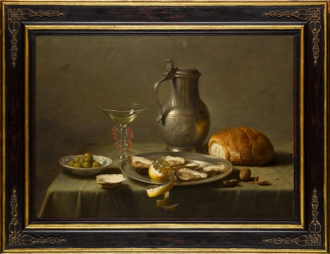Gospel in Art: I am the living bread which has come down from heaven

Painting by Johannes Hendrik Eversen, 1970, © Sotheby's London, 14 July 2021, sold £7,500
Source: Christian Art
Gospel of 5 May 2022
John 6:44-51
Jesus said to the crowd:
'No one can come to me unless he is drawn by the Father who sent me, and I will raise him up at the last day.
It is written in the prophets: They will all be taught by God, and to hear the teaching of the Father, and learn from it, is to come to me.
Not that anybody has seen the Father, except the one who comes from God: he has seen the Father. I tell you most solemnly, everybody who believes has eternal life.
'I am the bread of life. Your fathers ate the manna in the desert and they are dead; but this is the bread that comes down from heaven, so that a man may eat it and not die.
I am the living bread which has come down from heaven. Anyone who eats this bread will live for ever; and the bread that I shall give is my flesh, for the life of the world.'
Reflection on the Painting
Today's painting was painted only in 1970. I am sure that at first glance you may have thought that it was a 17th-century Dutch still life painting. Johannes Hendrik Eversen was born in 1906 in The Hague and grew up being surrounded by such paintings. In fact, he was descendant of Adrianus Eversen, a well known 19th- century still life and landscape artist.
Against a plain background, we see a loaf of bread, symbolic of the body of Christ. Untouched bread further implied the strength and wholeness of salvation. In our reading today we hear Jesus say, 'I am the bread of life'. This means that he guarantees that he can satisfy our deepest needs and longings. By equating himself with bread, Jesus is saying he is the vital, essential nourishment for life.
Our painting also features oysters, which in old master paintings conveyed the spirit of temptation. Oysters need to be opened and then can be eaten. If we leave ourselves open to temptation we may well eat what is on offer. The bitterness of the lemon, combined with its high price tag at the time, is symbolic of the deceptive beauty of carnality. Especially, as here, a semi-peeled lemon would have had an erotic connotation in the 17th century. The glass looks fragile, yet holds wine. It stands for the brittle ephemerality of life. Finally, the pewter pitcher, rather than a silver vessel, accentuates the simplicity of life. Pewter was known as 'poor man's silver'. Pewter is duller, darker, and softer than silver, so artists often preferred incorporating pewter objects in their still life paintings, as it accentuated the need for simplicity in life. Look in particular at the reflection of the oysters and bread in the belly of the pewter tankard.
LINKS
Christian Art: www.christian.art
Today's image: https://christian.art/daily-gospel-reading/john-6-44-51-2022/


















